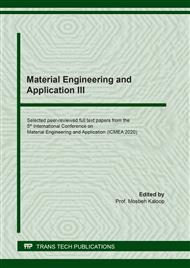[1]
Davidson D, Chan K, McClung R, Hudak S. 4.05 - Small Fatigue Cracks. In: Milne I, Ritchie RO, Karihaloo B, editors. Comprehensive Structural Integrity. Oxford: Pergamon; 2003. 129-64.
DOI: 10.1016/b0-08-043749-4/04073-8
Google Scholar
[2]
Shukla A, Harsha SP. Vibration Response Analysis of Last Stage LP Turbine Blades for Variable Size of Crack in Root. Procedia Technology. 23(2016) 232-9.
DOI: 10.1016/j.protcy.2016.03.022
Google Scholar
[3]
Bhagi LK, Gupta P, Rastogi V. Fractographic investigations of the failure of L-1 low pressure steam turbine blade. Case Studies in Eng. Failure Analysis. 2013 1(2) 72-8.
DOI: 10.1016/j.csefa.2013.04.007
Google Scholar
[4]
Segura JA, Castro L, Rosales I, Rodriguez JA, Urquiza G, Rodriguez JM. Diagnostic and failure analysis in blades of a 300MW steam turbine. Engineering Failure Analysis. 2017 82 631-41.
DOI: 10.1016/j.engfailanal.2017.04.039
Google Scholar
[5]
Zhuang Z, Liu Z, Cheng B, Liao J. Chapter 3 - Dynamic Crack Propagation. In: Zhuang Z, Liu Z, Cheng B, Liao J, editors. Extended Finite Element Method. Oxford: Academic Press; 2014. 33-50.
DOI: 10.1016/b978-0-12-407717-1.00003-0
Google Scholar
[6]
Salimi-Majd D, Shahabi F, Mohammadi B. Effective local stress intensity factor criterion for prediction of crack growth trajectory under mixed mode fracture conditions. Theoretical and App. Fracture Mech. 2016 85 207-16.
DOI: 10.1016/j.tafmec.2016.01.009
Google Scholar
[7]
Shlyannikov VN, Zakharov AP, Yarullin R. A plastic stress intensity factor approach to turbine disk structural integrity assessment. Frattura ed Integrità Strutturale. 2016 10 193-9.
DOI: 10.3221/igf-esis.37.25
Google Scholar
[8]
Azevedo CRF, Sinátora A. Erosion-fatigue of steam turbine blades. Engineering Failure Analysis. 2009 16(7) 2290-303.
DOI: 10.1016/j.engfailanal.2009.03.007
Google Scholar
[9]
Cano S, Rodríguez JA, Rodríguez JM, García JC, Sierra FZ, Casolco SR, et al. Detection of damage in steam turbine blades caused by low cycle and strain cycling fatigue. Eng. Failure Analysis. 2019 97 579-88.
DOI: 10.1016/j.engfailanal.2019.01.015
Google Scholar
[10]
Tanuma T. 13 - Development of last-stage long blades for steam turbines. In: Tanuma T, editor. Advances in Steam Turbines for Modern Power Plants: Woodhead Publishing; 2017. 279-305.
DOI: 10.1016/b978-0-08-100314-5.00013-0
Google Scholar
[11]
Lin CM, Yen SH, Tran L, Wu YE, Wu HC, Tsai HL. Experimental investigation into microstructure, metallurgy and mechanical properties of AISI 422 stainless steel weldments produced using fibre laser welding direct forming. Canadian Metallurgical Quarterly. 2016 55(3) 285-94.
DOI: 10.1080/00084433.2016.1196850
Google Scholar
[12]
Erke Wang, Thomas Nelson, Rauch R. Back to Elements - Tetrahedra vs. Hexahedra. International Ansys Conference2004.
Google Scholar
[13]
Bai Q, Bai Y. 9 - Thermal Expansion Design. In: Bai Q, Bai Y, editors. Subsea Pipeline Design, Analysis, and Installation. Boston: Gulf Professional Publishing; 2014. 187-220.
DOI: 10.1016/b978-0-12-386888-6.00009-2
Google Scholar
[14]
Ince A, Glinka G. A modification of Morrow and Smith–Watson–Topper mean stress correction models. Fatigue & Fracture of Engineering Materials & Structures. 2011 34 854-67.
DOI: 10.1111/j.1460-2695.2011.01577.x
Google Scholar
[15]
Göldner H. Broek, D., Elementary Engineering Fracture Mechanics, Leyden. Noordhoff International Publishing. 1974. 408 S., Dfl. 120.00. $ 52.25. ZAMM - Journal of Applied Mathematics and Mechanics / Zeitschrift für Angewandte Mathematik und Mechanik. 1978 58(9) 423.
DOI: 10.1002/zamm.19780580919
Google Scholar
[16]
Chang K-H. Chapter 3 - Design Optimization. In: Chang K-H, editor. Design Theory and Methods Using CAD/CAE. Boston: Academic Press; 2015. 103-210.
DOI: 10.1016/b978-0-12-398512-5.00003-7
Google Scholar
[17]
Pavlina EJ, Van Tyne CJ. Correlation of Yield Strength and Tensile Strength with Hardness for Steels. Journal of Materials Engineering and Performance. 2008 17(6) 888-93.
DOI: 10.1007/s11665-008-9225-5
Google Scholar
[18]
Khodabakhshi F, Haghshenas M, Eskandari H, Koohbor B. Hardness−strength relationships in fine and ultra-fine grained metals processed through constrained groove pressing. Materials Sci. and Eng. A. 2015 636 331-9.
DOI: 10.1016/j.msea.2015.03.122
Google Scholar
[19]
Qu S, Huang CX, Gao YL, Yang G, Wu SD, Zang QS, et al. Tensile and compressive properties of AISI 304L stainless steel subjected to equal channel angular pressing. Materials Sc. and Eng. A. 2008 475(1) 207-16.
DOI: 10.1016/j.msea.2007.04.111
Google Scholar
[20]
Gunasekaran S, Kuppuraj P, Priya K. Determine the Chemistry of Selected Steel by NDE Technique of Positive Material Identification (PMI). Int. Jour. of Sci. and Res. (IJSR). 2014 3 662-6.
Google Scholar
[21]
Saidi D, Zaid B, Souami N, Negache M, Ahmed AS. Microstructure and fracture mode of a martensitic stainless steel steam turbine blade characterized via scanning auger microscopy and potentiodynamic polarization. IOP Conference Series: Mat. Sci. and Eng. 2014 60 012004.
DOI: 10.1088/1757-899x/60/1/012004
Google Scholar
[22]
Jiang F, Weiwei Z, Rongqiao W, Xiuli S, Zhiying C. Research on Structural Design and Optimization of Turbine Blade Shroud. ASME 2012 Gas Turbine India Conference, GTINDIA 2012. (2012).
DOI: 10.1115/gtindia2012-9590
Google Scholar
[23]
Naumann HG. Steam Turbine Blade Design Options: How To Specify Or Upgrade. Texas A&M University Turbomachinery Laboratories. 1982 29-50.
Google Scholar
[24]
Cheng K, Peng Z, Yang H, Zhou D. Influence of the blade shroud gap to the natural frequency of the interlocked turbine blade. Proceeding of International Conference on Power Engineering, ICOPE 2009. 2009 2009.2.
DOI: 10.1299/jsmeicope.2009.2._2-517_
Google Scholar
[25]
Stress Intensity Factors of Cracks. In: Schijve J, editor. Fatigue of Structures and Materials. Dordrecht: Springer Netherlands; 2009. 105-40.
Google Scholar
[26]
Broberg KB. 4 - Elastostatic Cracks. In: Broberg KB, editor. Cracks and Fracture. San Diego: Academic Press; 1999. 99-246.
DOI: 10.1016/b978-012134130-5/50005-2
Google Scholar
[27]
Hedia H, Aldousari S, Fouda N. Effect of crack configuration on the stress intensity factors for different fracture modes of homogenous bimaterial: A three-dimensional finite element analysis. M E T A L L - F O R S C H U N G. 2009;63.
DOI: 10.3139/120.110107
Google Scholar


